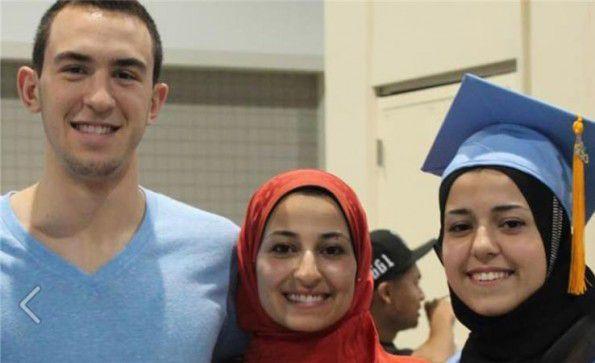
Here is a trend. In the weeks between the Jan. 7 Charlie Hebdo shooting and Jan. 23, people plotted against or attacked Parisian Muslims 128 times. According to the French Council for the Muslim Religion, people threatened or attacked Parisian Muslims 133 times in 2014 alone. This is a dramatic increase in the rate in which Muslim people are being targeted in hate crimes.
The trend continues. Police officers in Madison, Alabama stopped Chirag Patel, an Indian-American grandfather, because people called in to say a suspicious person was walking the neighborhood. Because Patel spoke no English, officers were not able to communicate with him effectively. They slammed him to the ground and nearly paralyzed him. Patel’s lawyers claim the police used excessive force because of Patel’s ethnic background, according to Al Jazeera America.
The same sentiment goes further. Three Muslim students were shot execution style in a condominium complex near the University of North Carolina at Chapel Hill campus Wednesday. Newlyweds Yusor Mohammad, 21, Deah Shaddy Barakat, 23, and Yusor’s sister Razan Mohammad Abu-Salha, 19, were all pronounced dead at the scene. The dispute allegedly grew from tension related to a parking space, Fox News reported just an hour after the shooting.
This is a trend the mainstream media was too uncomfortable to call when the news broke. This is a trend of violence against Muslims, Arabs or anyone seemingly Arab. And so #MuslimLivesMatter began to trend on Twitter.
Throughout Wednesday, people tweeted the hashtag along with #ChapelHillShooting, to criticize the western media’s coverage of what happened in North Carolina. Within hours, #BlackLivesMatter began to surface again while people drew relations between the disproportionate police violence against black men in America.
Twitter’s response soon became animated with cartoons surfacing as quickly as those labeled #JeSuisCharlie that spread after the Charlie Hebdo attack. People drew television reporters wearing Fox, CBS, NBC, CNN and ABC lapels ignoring three dead bodies on the ground. One cartoon reads, “3 Young Muslims killed by a lone gunner? No breaking news here!”
Then we get to the tweet of Yasir Qadhi, a Muslim theologian in Tennessee.
“I wonder when all world leaders will come and hold hands and march on the streets of Chapel Hill to condemn Islamphobia. #MuslimLivesMatter.”
Haya Barakat, a family member of the victims of the Chapel Hill shooting, tweeted something heartbreaking. “Here is the hypocrisy the hashtag pointed out today. My cousin, his wife and sister in law were murdered for being muslim. Someone tell me racism/hate crimes don’t exist. #MuslimLivesMatter.”
Painfully enough, the deceased couple’s wedding photos are circulating Twitter as well with the same trending hashtags.
Few journalists labeled the murders as bias crimes at the get-go. NBC News foreign correspondent Ayman Mohyeldin did not tweet his opinion, but he wrote a status that read, “Is it appropriate to use the word terrorism to describe the killing of 3 Muslims in North Carolina?” Even without the hashtag, he invokes the sentiment that mainstream outlets and pundits were not connecting the dots between the increasing rates of violence against Muslims in the western world.
Fun fact: Mohyeldin has almost 79 thousand more followers on his Facbeook page than on his Twitter account, so this opinion potentially reached a lot more people.
This social media response brings a whole new conversation to the table. Although the Chapel Hill shooter was not charged with a hate-motivated crime, people are still discussing the implications of violence against Muslims and people of color in the United States.
People began to ask why major western news outlets seem to ignore this trend. While the mainstream media cannot draw these conclusions early on in the investigation, citizens on social media have no boundaries and can call a spade a spade. News outlets must report the facts available, so major television networks cannot just label this a hate crime without all the evidence present.
Reporters for The New York Times and other outlets did mention the possibility of bias playing a major role. Chapel Hill Police Chief Chris Blue touched on the idea in a news release, saying the shooting could have been “hate-motivated,” but there was not sufficient evidence to draw that conclusion at the time. Craig Stephen Hicks, the suspected shooter, was charged for the three murders, but he was not slapped with a formal accusation of committing a hate crime. The Washington Post published a story Wednesday night called, “Three Muslims killed in shooting near UNC; police, family argue over motive,” to highlight the debate on whether or not a parking space was really responsible, or if the shooter’s bigotry and hatred boiled over. But no officials called it a hate-crime as of yet.
Here is the problem with news reporting and having the freedom to “call it like it is”: News organizations ethically cannot draw conclusions without all the evidence present. Journalists are taught to remain as unbiased as possible until the whole story is out. Unless an official calls it a hate crime, the murders will always be documented as alleged bias-backed murders.
And this is where social media broke into the story.
The free dialogue is now happening all on social media. With every hashtag, people can debate the implications of the story while mainstream media keeps the country up to date on every new detail. As we have seen with #BlackLivesMatter, #MuslimLivesMatter will make headlines for the next few days, and hopefully that will get more people thinking about the underlying issues behind this heinous trend.